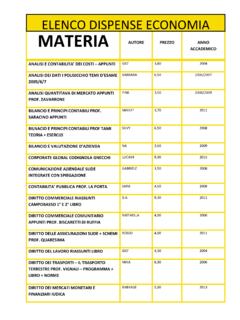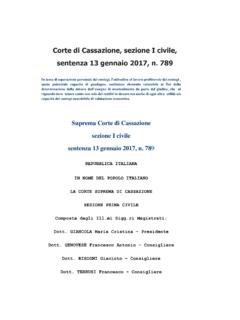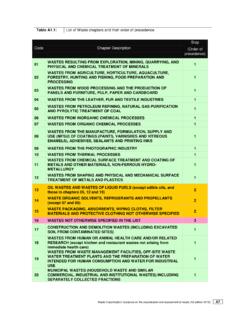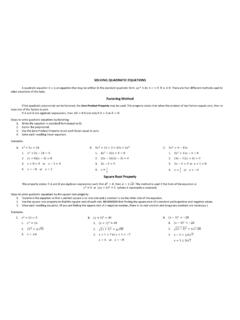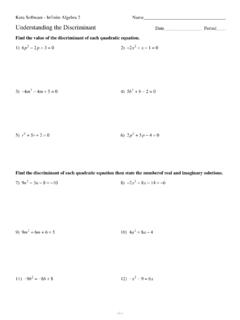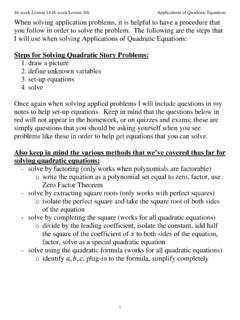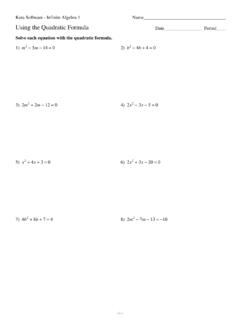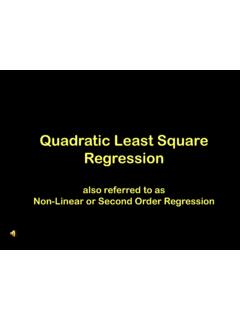Transcription of 5: ROOTS OF A QUADRATIC EQUATION
1 : ROOTS OF A QUADRATIC EQUATION The general form of a QUADRATIC EQUATION We have grown accustomed to recognising a QUADRATIC EQUATION in the form #+ + =0. In this section, we will be introduced to a new format for such a QUADRATIC EQUATION . This format would express the QUADRATIC in the form of its ROOTS . It is a convenient form to know and it allows us the flexibility to switch from this form to the standard form. ROOTS of a QUADRATIC EQUATION ( ) A QUADRATIC EQUATION in x is of the general form , where a, b and c are constants.
2 If we divide each term by a, then the QUADRATIC EQUATION can be expressed in an equivalent form with the coefficient of x2 is equal to one as shown below. Now consider and as the ROOTS of the QUADRATIC . We can now rewrite the QUADRATIC in the form: . By expanding we get, . (2) EQUATION (2) is an equivalent form of EQUATION (1). In fact, any QUADRATIC EQUATION , in x, can always be expressed in the form of its ROOTS . We can replace () by the sum of the ROOTS and by the product of the ROOTS , to obtain the following form for a QUADRATIC EQUATION .
3 Sum and product of the ROOTS of a QUADRATIC EQUATION equations (1) and (2) above are two equivalent forms of a QUADRATIC EQUATION . Equating both forms we get: When we equate coefficients, the following is obtained: and . We can now make a general statement about the ROOTS of a QUADRATIC . For the QUADRATIC EQUATION , the sum of the ROOTS and the product of the ROOTS . Example 1 If and are the ROOTS of the QUADRATIC EQUATION , determine (i) the sum of the ROOTS and (ii) the product of the ROOTS . Solution In the QUADRATIC EQUATION a =1, b = 3 and c = 2.
4 (i) The sum of the ROOTS , (ii) The product of the ROOTS , . Example 2 The QUADRATIC EQUATION has ROOTS and . a) Obtain the EQUATION whose ROOTS are and . b) Obtain the EQUATION whose ROOTS are and . Solution If the EQUATION has ROOTS and , then =1, = 4 and =3. Hence, and To obtain an EQUATION whose ROOTS are +1 and 20axbxc++=2200 (1)axbxcbcxxaa++=++=()()0xxab--=()20xxab ab-++=ab+ab()2sumofrootsproductofroots0x x-+=()22bcxxxxaaabab++=-++baab+=-caab=20 axbxc++=ba=-ca=ab2320xx-+=2320xx-+=baab+ =-()331ab--+==caab=221ab==2430xx-+=ab1a+ 1b+2a2b2430xx-+=ab()4ab+=3ab=Copyright 2019.
5 Some Rights Reserved. 1 of +1, we can substitute these ROOTS in the following EQUATION : This is the required EQUATION . Part b) To obtain an EQUATION whose ROOTS are # and #, we substitute these ROOTS in: [Recall: ] This is the required EQUATION . Example 3 Given that has real ROOTS which differ by 4, determine i. the value of each root ii. the value of k. Solution If we let be the smaller real root, then the other will be ( + 4). Then the sum of the ROOTS is : + ( + 4) = 2 +4 The product of the ROOTS is ( +4). From the given EQUATION , The sum of the ROOTS is: -(k-5) The product of the ROOTS is: -k Equating coefficients, we have: Sum of ROOTS 2 +4 = -(k-5) 2 +4 = - k +5 k = 1- 2 (1) Product of ROOTS ( +4) = -k = ( +4) (2) Equating equations (1) and (2) to eliminate k, we have: # 4 =1 2 #+2 +1=0 ( +1)( +1)=0 =-1 The value of k: k = 1- 2 = 1-2(-1)= 3 ROOTS are -1 and -1 + 4 The ROOTS are -1 and 3.
6 Alternative Method If we let be the smaller real root, then the other will be ( + 4). Hence the QUADRATIC EQUATION may be expressed as Equating coefficient of x, we obtain Equating constant terms, we obtain ROOTS are -1 and -1 + 4 The ROOTS are -1 and 3. ()2sumofrootsproductofroots0xx-+=()()222 2[( 1) ( 1)] [( 1)( 1)] 0[() 2)] [() 1] 042 341 0680xxxxxxxxababababab-++++++=-++++++=-+ +++=-+=()2sumofrootsproductofroots0xx-+= ()()()()222222222200xxxxabababab-++ =-++=()2222ababab+=++()()()()(){}()22222 2220423 3010 9 0xxxxxxababab-+-+=--+=-+=()250xkxk+--=() 250xkxk+--=\()()()()()224040440xaxxaxxxa xxaaaaa--+=---=--+-+=()()222440xxaaa+--+ +=245ka--=-24 51212kkkaaa--=-=--\=()2222224114221222 0412 88 4 0690303kkkkkkkkkkkkkkkkaa+=--- \+=- -++-+=-++-+=-+=-==13 When, 3, 12ka-===-\Copyright 2019.
7 Some Rights Reserved. 2 of 2

